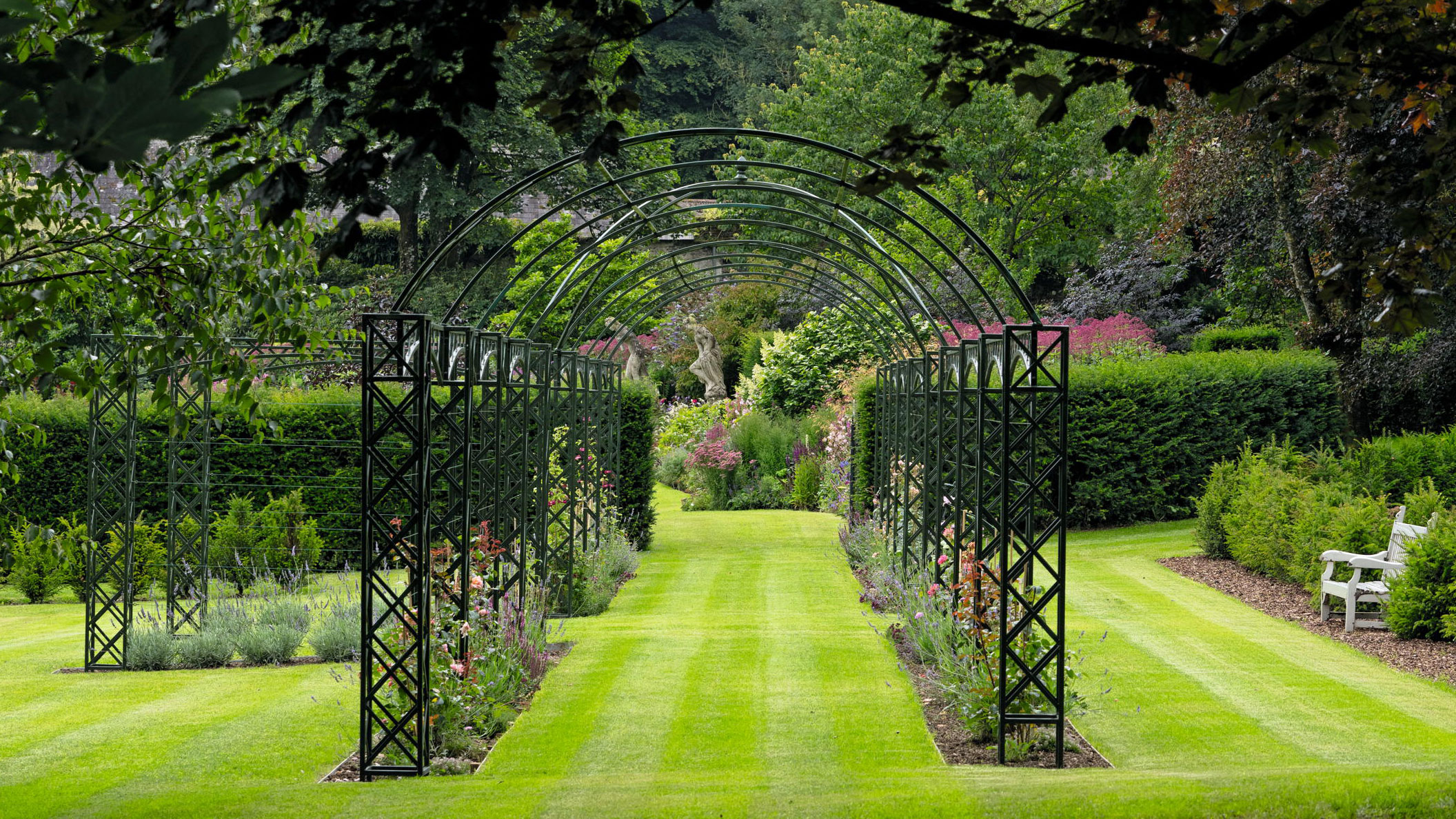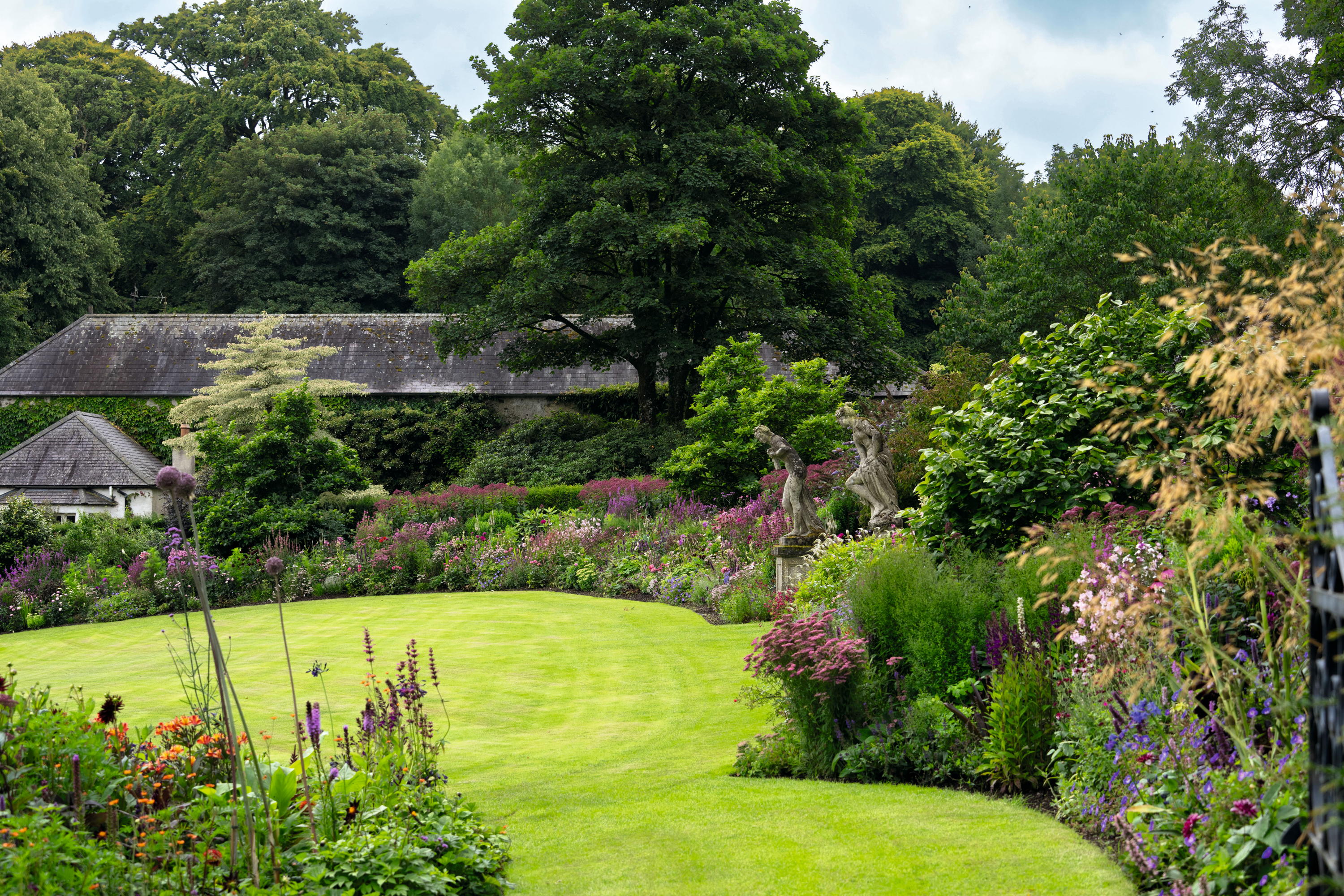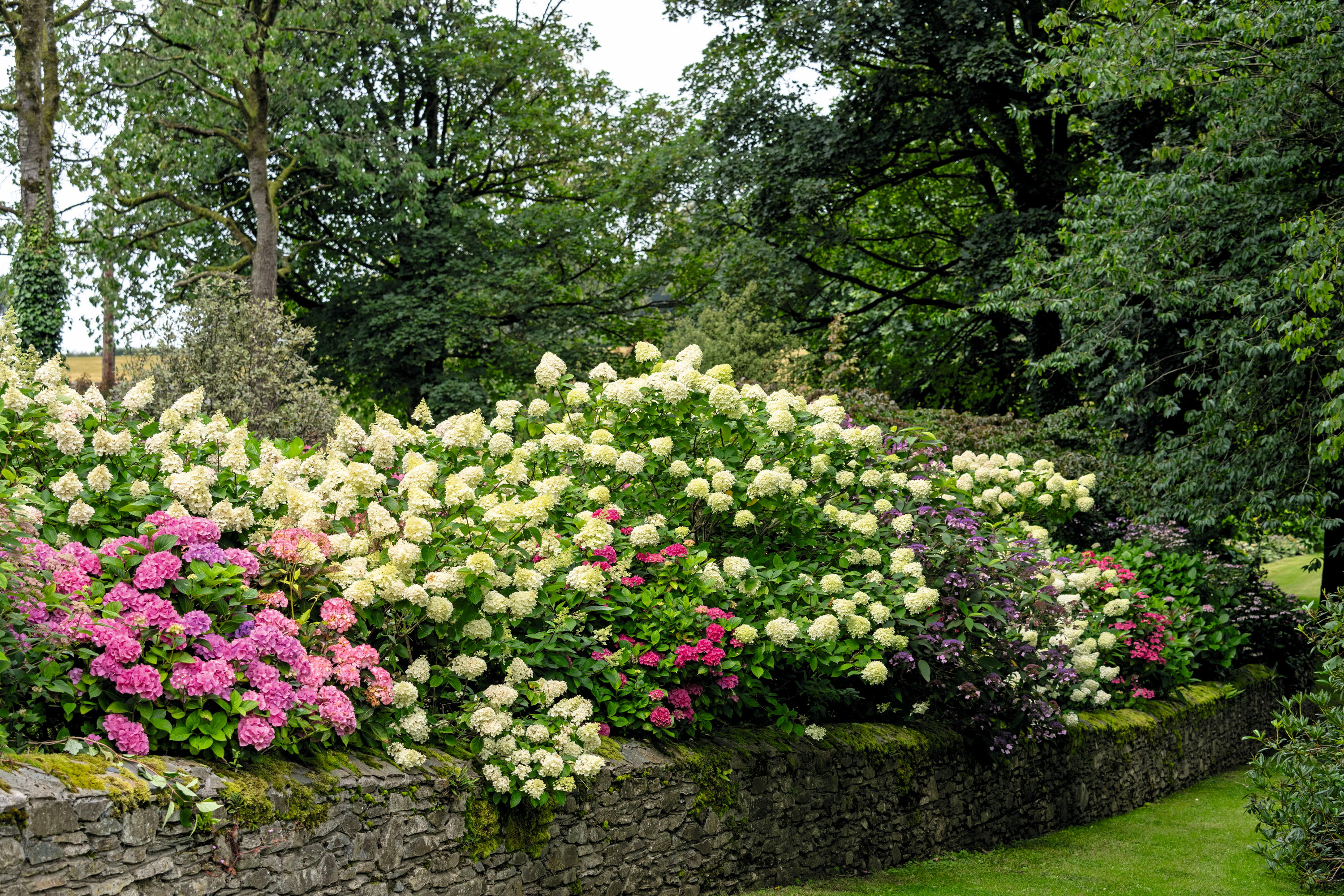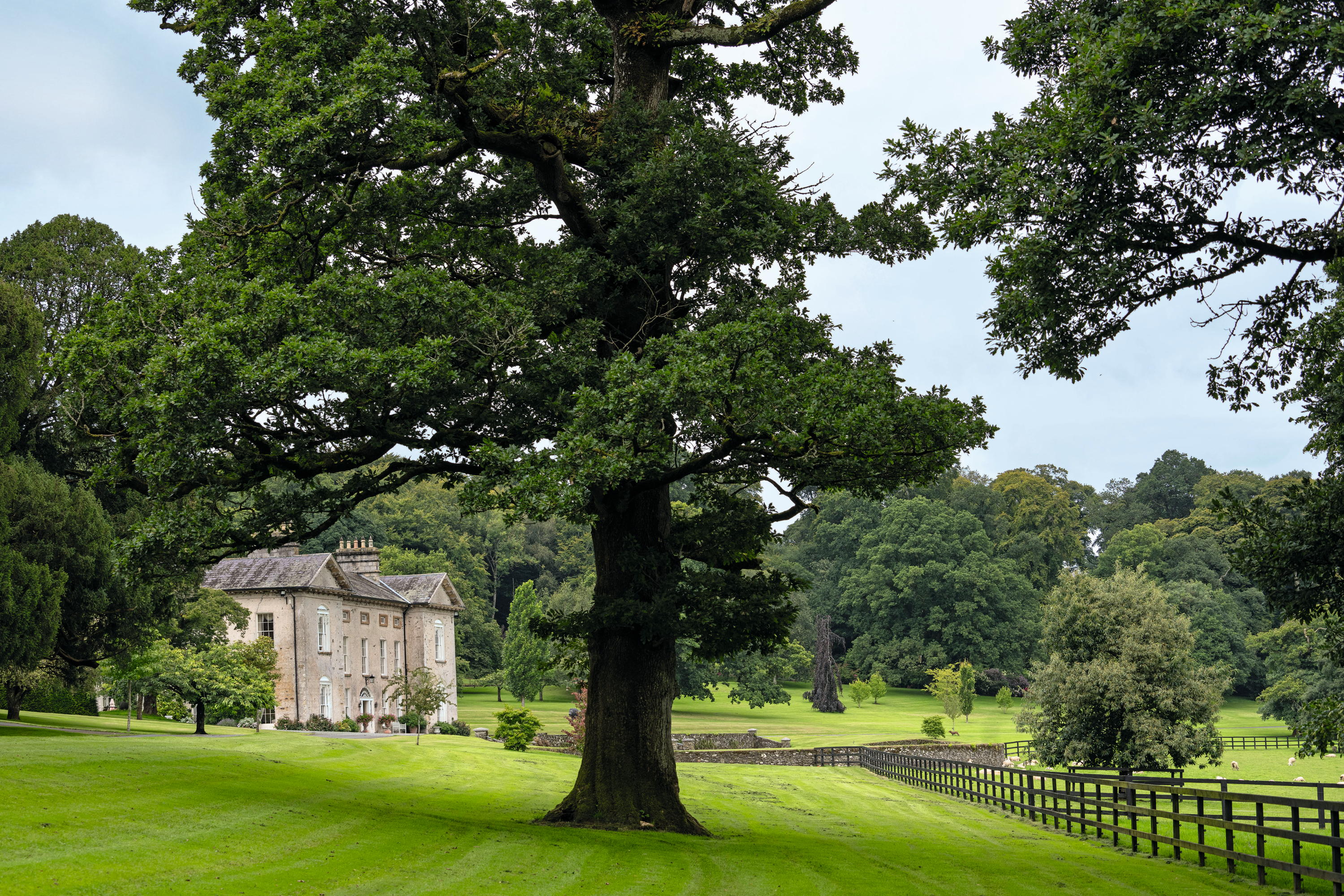Ballynure House: The magical estate that transformed its bramble-covered historic garden into a pollinator paradise
Where brambles once engulfed the historic gardens at Ballynure House in Co Wicklow, Ireland — home of Clare Reid Scott — colourful flower borders now hum with pollinators. Photographs by Jonathan Hession.

As soon as you enter the barely there, wrought-iron gates of Ballynure House in Co Wicklow, Ireland, the estate deploys its magic. A small lake appears on your left, a flawless Monet painting with a gently arched bridge and a mournful weeping willow. Two mute swans glide across the glassy surface. Further on, the leisurely avenue is densely planted with young oak and beech. Their slim trunks partially screen the view, as green leaves confer a pale, watery light.
The vista opens again on a handsome pastoral landscape where paddocks and farm fields sweep down to a fringe of woodland along the fast-flowing River Greese. The Georgian house, assuredly pure in all its lines and a warm biscuity colour, comes into sight. It commands the pleasing bucolic prospect and that of the distant mountains of Keadeen and Lugnaquilla.
Ballynure House, together with its 35 acres of gardens and pleasure grounds, is set into a 300-acre farm. It is impeccably maintained and continually improved. It was not always so. When the late David Reid Scott inherited from his grandparents in 1976, the property — which had been in the family since 1617 — was in a sad state. As is the way of old buildings, the house had begun to crumble and rampant scrub had engulfed the gardens. By the 1990s, Reid Scott, an investment banker, was able to start restoring the house and gardens. Both were dear to him; he and his brother, Malise, had been orphaned young and had been largely brought up by their grandparents in the old house. Their grandmother, Star Mitchell, had been a great gardener, as was her sister, Phyllis, who moved in temporarily during the Second World War, and never left.

Co Wicklow's generous rain keeps lawns green and borders abundant. The late allium 'Summer Drummer' stands 6ft tall on the left. The well-preserved farmyard buildings behind date from about 1750.
Reid Scott died in 2020 after a riding accident, but his wife, Clare, shared his passion for the historic estate and has carried on his work. Their son, Nico (who recently graduated from university), is undaunted by the thought of inheriting in the coming years: ‘Dad was so organised. He left it all in such an amazing state. It is so well managed, and that takes off the stress.’
Clare is ably supported by an enthusiastic staff, including head gardener Brian O’Reilly and farm manager Mick Murtagh. ‘They are employed,’ she says, ‘but they are family. I couldn’t live without any single one of them.’
In the 1990s, the laurels, brambles and saplings that crowded around the house were bulldozed away and the land was shaped into graceful contours. Cool, verdant lawns now act as a foil for the handsome and stalwart house, as crescent-shaped herbaceous borders on the south and west sides make a brightly-embroidered collar. Reid Scott loved the razzle-dazzle of fiery-toned flowers, although his wife prefers ‘pretty and lovely pastels’. Plantswoman June Blake — whose remarkable garden is 30 minutes up the road, near Blessington — was brought in to help with the planting.

‘Don’t be afraid to cut your hydrangeas hard in spring. Feed them and they will come back,’ says head gardener Brian O’Reilly.
The four beds that make up the borders have distinct moods: hot for him and cool for her. Lofty eutrochiums, more than 9ft tall, are repeated in beds of both temperatures, lending rhythm and consistency. They are mobbed by dozens of small tortoiseshell butterflies. Brian is keen on pollinators and grows as many attractant plants as possible. The caterpillars of the colourful vanessids (small tortoiseshells, red admirals and commas, among others) are sustained by nettles in the woods and all along the field margins.
Exquisite houses, the beauty of Nature, and how to get the most from your life, straight to your inbox.
The hot beds are filled with extrovert plants, such as red monarda and bistort, apricot-and-plum alstroemeria and hot-pink echinaceas. Dramatic dahlias brashly grab attention; among them are ‘Natal’, a deep-red pom-pom, and the semi-double ‘Waltzing Matilda’, which is suffused with coral, cerise and orange. The quieter beds, known as ‘Clare’s beds’, are home to gentler pinks, mauves and whites: phloxes, veronicastrum, agastache, salvia, Allium ‘Summer Beauty’ and the dahlia ‘Paradise City’. Lobelia ‘Hadspen Purple’ adds a note of vivid violet and annual cosmos, both white and pink, is used to fill gaps in late summer. Because Ballynure can get a ‘good bit of frost’, Brian lifts and stores the borderline and tender plants: dahlias, lobelias, salvias. As the wind can be forceful and damaging, plants ‘are staked to the hilt — but invisibly. A shed-load of staking goes on here. If you stand here long enough, you’ll be staked!’

The late-Georgian Ballynure House has been sensitively restored and is a fine example of early-1800s architecture — and just as delightful as the gardens that surround it.

A box parterre offers a formal interlude behind the house.
Brian O’Reilly’s of Ballynure on his favourite plants for pollinators
- At the start of the year, pulmonaria offers nourishment for queen bumblebees coming out of hibernation
- Nepeta gigantea ‘Six Hills Giant’ is relatively early flowering and can be cut back hard after blooming for another later flush; it is visited by all manner of insects, including the hummingbird hawk-moth
- Hyssop (Hyssopus officinalis) and borage are loved by bees, bumblebees and hoverflies and are easily grown from seed. Other popular members of the mint family (that don’t spread, unlike mint itself) are lesser calamint (Calamintha nepeta) and agastache
- Bistorta amplexicaulis ‘Fat Domino’ is a top feeding station from mid-summer into autumn for honeybees, hoverflies and solitary wasps. The Eutrochium genus is a magnet for butterflies: if space is limited, grow the smaller, 3ft-tall E. dubium ‘Little Joe’
- Hylotelephium ‘Herbstfreude’ (also known as Sedum ‘Autumn Joy’) is a good front-of-border plant, beloved of butterflies and honeybees
- Finally, the native water figwort (Scrophularia auriculata) bears small, brownish flowers on elegantly branching stems. Favoured by wasps and smaller bumblebees, it is readily propagated from cuttings
Hydrangea paniculata bears creamy blossoms over a long period and is used to back ‘Clare’s beds’. Farther away from the house, a gathering of different hydrangeas is massed along a low stone wall. The wall was built to retain an inconvenient, sloping bank and its awkwardness is completely disguised by the many-toned, candy-coloured flowerheads. Along another wall bordering the old farmyard, a flock of fuchsias flourishes, their thousands of little bells trembling in the breeze. Reid Scott loved fuchsias, so they are also planted in huge terracotta pots by the house.
Yew hedging is used throughout the garden to delineate spaces, provide shelter and create areas. It thrives at Ballynure, which is fitting, as the Irish name Baile an iubhair means town of the yew. There are mature yews here also, as well as many other fine trees in the parkland. The Reid Scotts have continually planted, so there are young and lithe specimens in attendance to the venerable, lichen-encrusted characters.
The different habitats — garden, grassland, woodland, river and lake — give sanctuary and sustenance to much wildlife. Wrens and robins nest in the tree ferns and house martins fly in each year from Africa to raise their chicks under the eaves of the old house. The lake, which was made in 1995, is visited by swans, herons, kingfishers and red squirrels. An osprey, a bird persecuted to extinction by the 19th century in Ireland, has been spotted. It is a scarce passage migrant that depends on fish for its diet.
The entire estate is, in the words of farm manager Mick: ‘Heaven! And no one knows it’s in here. That’s the best part, I think.’ Clare agrees: ‘As soon as I set foot in London, I’m counting the days till I can get back.’
This feature originally appeared in the print edition of Country Life — here's how you can subscribe to Country Life magazine.
-
 Bare roots: How to find the perfect rose and how to plant it
Bare roots: How to find the perfect rose and how to plant itTabi Jackson Gee moved to a cottage in Wiltshire, and went about finding the perfect rose to bring light and colour to the garden.
-
 Flying backwards, pink milk, and holding your breath. A Country Life quiz of animal facts
Flying backwards, pink milk, and holding your breath. A Country Life quiz of animal factsDo you know the difference between a bobbit worm and a mantis shrimp? You will soon.
-
 Bare roots: How to find the perfect rose and how to plant it
Bare roots: How to find the perfect rose and how to plant itTabi Jackson Gee moved to a cottage in Wiltshire, and went about finding the perfect rose to bring light and colour to the garden.
-
 A royal success: The King's gardens at Sandringham
A royal success: The King's gardens at SandringhamIn only three years, The King has overseen a remarkable resurrection of the gardens and parkland at Sandringham. Charles Quest-Ritson visits
-
 The trees that are as fine to eat as they are to look at
The trees that are as fine to eat as they are to look atMark Diacono doesn't grow many trees for the sake of the bounty they provide — but these are the notable exceptions.
-
 Bothered by brambles and snagged by sow thistles, but what is the point of all this thorny microaggression?
Bothered by brambles and snagged by sow thistles, but what is the point of all this thorny microaggression?Nature’s spiky deterrents — thorns, spines and prickles — may be quick to catch us out, but they can also prove to be a useful ally.
-
 The Tuscan gardens where the English and Italian traditions come together, and Yorkshire rhubarb grows happily beside spectacular citrus
The Tuscan gardens where the English and Italian traditions come together, and Yorkshire rhubarb grows happily beside spectacular citrusNick Dakin-Elliot, who gardens in Tuscany, is still moved by the Italian hilltop gardens that command some of the most beautiful views in the world.
-
 'My family wore wool at a time when everyone else had cast it off in favour of manmade fabrics': The knitwear pioneer who is one of David Beckham's countryside champions
'My family wore wool at a time when everyone else had cast it off in favour of manmade fabrics': The knitwear pioneer who is one of David Beckham's countryside championsJulie Harding speaks to Rachel Carvell-Spedding the founder of British knitwear brand Navygrey, and one of David Beckham's countryside champions.
-
 James Alexander-Sinclair: Making a new garden for someone is 'thrilling', but we need more sensitive and skilled gardeners to look after them
James Alexander-Sinclair: Making a new garden for someone is 'thrilling', but we need more sensitive and skilled gardeners to look after themPay your gardeners properly, says James Alexander-Sinclair as, without them, you will have no garden.
-
 'Seeing the work that people are doing all around the world has given me hope for the future': The young naturalist who is one of David Beckham's countryside champions
'Seeing the work that people are doing all around the world has given me hope for the future': The young naturalist who is one of David Beckham's countryside championsJulie Harding speaks to Ramandeep Nijjar, a young naturalist who has made an impact on the world even before finishing university, and one of David Beckham's countryside champions.